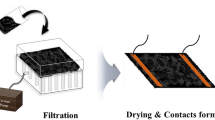We present the results of an experimental study of the effective thermal conductivity and specific heat capacity of fabrics made from chemical fibers having different structures, in the bulk density range 383-606 kg/m3. We give equations for determining the effective thermal conductivity coefficient and the effective internal surface of the material, obtained on the basis of a macroquantum transfer mechanism. We give an example of a calculation using these equations. We describe and analyze the new parameters: the relaxation coefficients, the temperature and volume form factor for the macrocell. The results obtained for all the studied materials are generalized as a dependence of the thermal conductivity coefficient on a combination of physical constants.




Similar content being viewed by others
References
A. V. Lykov, Theory of Thermal Conductivity [in Russian], Vysshaya Shkola, Moscow (1967). 600 pp.
M. Planck, Principles of Conservation of Energy [Russian translation from German], Gostekhteorizdat, Moscow/ Leningrad (1938). 235 pp.
N. A. Umov, in: Equations of Motion for Energy in Solids. Selected Works [in Russian], Gostekhteorizdat, Moscow (1950), pp. 151-200.
D. O. Svetlov, V. V. Isaev, and Yu. V. Svetlov, “Study of the thermal conductivity of thermally insulating and textile materials based on the macroquantum thermodynamic method,” in: Proceedings, Fourth International Scientific and Applied Conference on Modern Energy-Saving Thermal Technologies, SÉTT-2011 [in Russian], Moscow (2011), Vol. 2, pp. 158-165.
E. Schrödinger, Naturwiss., 14, 664 (1926).
V. P. Maikov, Expanded Version of Classical Thermodynamics: The Physics of Discrete Space-Time [in Russian], Izdat. MGUIÉ, Moscow (1997). 160 pp.
D. O. Svetlov, V. V. Isaev, and Yu. V. Svetlov, “Effective thermal conductivity of materials with capillary porous and fiber structure, based on the macroquantum thermodynamic method,” MGUTU, Moscow. Technologies of the Twenty-First Century in Food, Processing, and Light Industry [in Russian], (2012), No. 6, Pt. 1. 11 pp.
M. P. Malkov, I. B. Danilov et al., Handbook on the Physicotechnical Principles of Deep Cooling [in Russian; M. P. Malkov, ed.], Gosénergoizdat, Moscow (1963). 416 pp.
É. I. Denisova and A. V. Shak, “Thermal conductivity measurement on the IT-λ-400 instrument. Operating Manual,” UGTU-UPI, Ekaterinburg (2005). 35 pp.
Author information
Authors and Affiliations
Additional information
Translated from Khimicheskie Volokna, Vol. 46, No. 1, pp. 47-51, January-February, 2014.
Rights and permissions
About this article
Cite this article
Svetlov, D.O., Isaev, V.V. & Svetlov, Y.V. Heat Capacity and Thermal Conductivity of Fabrics Based on Chemical Fibers. Fibre Chem 46, 45–50 (2014). https://doi.org/10.1007/s10692-014-9558-9
Published:
Issue Date:
DOI: https://doi.org/10.1007/s10692-014-9558-9



